Marcia Thornton Jones's Blog, page 98
June 12, 2019
Lessons Learned.
Stuck in the closet in my work room, buried under copy paper and assorted office supplies lie two completed manuscripts. Two finished novels, written back in the 90's when I first thought about writing BIG. I'd had some success in publishing short stories in literary magazines and magazines for kids such as CICADA, and CRICKET. But I'd always wanted to try and write a book-length story.
So write, I did. Both stories had a beginning, middle, and end. Both stories had an arc and characters who changed through the story. But, like many newbies to the art of novel writing, both stories went unpublished. It wasn't for lack of trying - I'd mailed out each manuscript several times, waiting for responses that came in the form of the dreaded DEAR AUTHOR. Why wasn't I making progress? Why wasn't my work at least getting personalized rejections?
It wasn't until I joined critique groups and began getting constructive feedback on my writing that I was able to answer those questions.
Here is what those manuscripts taught me:
1. It takes time to hone and develop a VOICE. That difficult-to-describe-unique-quality all writers have once they become better at the craft of writing. My VOICE in those initial manuscripts was all over the place - sometimes MG, sometimes YA, sometimes adult. No wonder those stories haven't seen the light of day.
2. You need more than one pair of eyes to read a manuscript and find the gems amid the mess that is a first, second, or umpteenth draft. Sharing work opens up so many paths for the story to grow and develop beyond initial expectations.
3. It takes much more than just a character "doing something" or "having a problem" to make a novel worth publishing. Reading the books of other authors gave me valuable insight in character development, conflict, emotional impact, figurative language, and many other aspects that make a successful story. Reading widely makes writing better.
4. Finally, just like the characters in our stories, we can measure our own growth as writers by recognizing how much we've learned since those first manuscripts. Our characters don't solve their problems without some kind of struggle and more than one attempt. Neither should we expect to pen a successful novel without a dud or two.
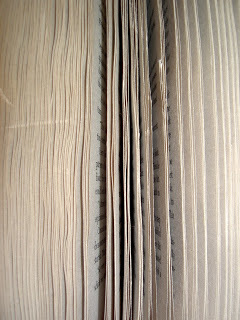
Those unpublished manuscripts proved that I could write and finish a book-length tome. That was enough encouragement to keep on writing. They are a reminder of how far I've come.
So write, I did. Both stories had a beginning, middle, and end. Both stories had an arc and characters who changed through the story. But, like many newbies to the art of novel writing, both stories went unpublished. It wasn't for lack of trying - I'd mailed out each manuscript several times, waiting for responses that came in the form of the dreaded DEAR AUTHOR. Why wasn't I making progress? Why wasn't my work at least getting personalized rejections?
It wasn't until I joined critique groups and began getting constructive feedback on my writing that I was able to answer those questions.
Here is what those manuscripts taught me:
1. It takes time to hone and develop a VOICE. That difficult-to-describe-unique-quality all writers have once they become better at the craft of writing. My VOICE in those initial manuscripts was all over the place - sometimes MG, sometimes YA, sometimes adult. No wonder those stories haven't seen the light of day.
2. You need more than one pair of eyes to read a manuscript and find the gems amid the mess that is a first, second, or umpteenth draft. Sharing work opens up so many paths for the story to grow and develop beyond initial expectations.
3. It takes much more than just a character "doing something" or "having a problem" to make a novel worth publishing. Reading the books of other authors gave me valuable insight in character development, conflict, emotional impact, figurative language, and many other aspects that make a successful story. Reading widely makes writing better.
4. Finally, just like the characters in our stories, we can measure our own growth as writers by recognizing how much we've learned since those first manuscripts. Our characters don't solve their problems without some kind of struggle and more than one attempt. Neither should we expect to pen a successful novel without a dud or two.

Those unpublished manuscripts proved that I could write and finish a book-length tome. That was enough encouragement to keep on writing. They are a reminder of how far I've come.
Published on June 12, 2019 06:00
June 11, 2019
How I Knew
by Jody Feldman
 These are flowers in my yard. I didn’t plant them. I hired someone to do that. I don’t have the patience to garden even though I know how. I don’t have the patience to sew, even though I’ve taken several classes. Believe me; I’ve tried.
These are flowers in my yard. I didn’t plant them. I hired someone to do that. I don’t have the patience to garden even though I know how. I don’t have the patience to sew, even though I’ve taken several classes. Believe me; I’ve tried.
But I do have the patience to write.
There was a time when I didn’t think that was possible. I wanted the words that poured from my fingers to be perfect. Sure, I was up for a snip here and a tweak there, but I didn’t understand (or didn’t want to understand) the concept of wholesale changes.
Of digging up the flowerbed.
Or ripping apart the seams.
Of doing what was necessary to create the vision that was my goal. I was still at a point where I craved instant gratification from any creative process.
And then...
I signed up for a workshop on revision. The leader, the wonderful Darcy Pattison, told us—
Well, I don’t remember what she told us exactly. But here’s what I came away with. To create a story that might match my expectations, I’d have to get my fingernails dirty. Not just a little crusty, but downright filthy.
After that weekend, I grew hyper-aware of what it would take to create a publishable book. And I had doubts. Could I really rip apart my sentences and paragraphs and whole chapters like that? Could I rethink entire scenes? Could I bear to throw them out and completely retool?
Those doubts bombarded me,
for about 15 minutes.
Yes, I could. I could do all of that. And more.
That when I knew, how I knew, I could become a writer.
 These are flowers in my yard. I didn’t plant them. I hired someone to do that. I don’t have the patience to garden even though I know how. I don’t have the patience to sew, even though I’ve taken several classes. Believe me; I’ve tried.
These are flowers in my yard. I didn’t plant them. I hired someone to do that. I don’t have the patience to garden even though I know how. I don’t have the patience to sew, even though I’ve taken several classes. Believe me; I’ve tried.But I do have the patience to write.
There was a time when I didn’t think that was possible. I wanted the words that poured from my fingers to be perfect. Sure, I was up for a snip here and a tweak there, but I didn’t understand (or didn’t want to understand) the concept of wholesale changes.
Of digging up the flowerbed.
Or ripping apart the seams.
Of doing what was necessary to create the vision that was my goal. I was still at a point where I craved instant gratification from any creative process.
And then...
I signed up for a workshop on revision. The leader, the wonderful Darcy Pattison, told us—
Well, I don’t remember what she told us exactly. But here’s what I came away with. To create a story that might match my expectations, I’d have to get my fingernails dirty. Not just a little crusty, but downright filthy.
After that weekend, I grew hyper-aware of what it would take to create a publishable book. And I had doubts. Could I really rip apart my sentences and paragraphs and whole chapters like that? Could I rethink entire scenes? Could I bear to throw them out and completely retool?
Those doubts bombarded me,
for about 15 minutes.
Yes, I could. I could do all of that. And more.
That when I knew, how I knew, I could become a writer.
Published on June 11, 2019 04:00
June 8, 2019
What I DIDN'T Learn ... by Jane Kelley
This month's topic sent me digging through the actual folders in my actual filing cabinet. My first completed children's book manuscript was typed and mailed to an editor in the year 1984.
I wrote BERT TO THE RESCUE at a time when I was also writing plays, short stories, adult novels, essays -- basically anything I could think of in hopes of success. I had no idea what I was doing. No plan. No mentor. Just a naive belief that somehow or other success was around the corner.
"Bert" was based on a family legend. My great great aunt Elizabeth Moffett, who wrote for the Milwaukee Journal, used to talk for an imaginary cat named Bert. I combined Bert with my own miserable year at 4th grade. I knew someone who knew someone who knew someone at Knopf. And somehow got my manuscript read by an editor.
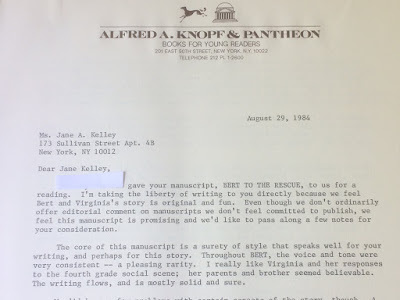
I remember being thrilled by this response -- even though, despite the praise, the envelope also contained my manuscript.

I incorporated the advice as best I could and resubmitted "Bert." A few months later, "Bert" came back, rejected once again, with more feedback from more editors.


So, dear readers, I'm sure you think that I immediately wrote another middle-grade novel, which was much much better because of the advice given to me by those three editors, and sent it to the first editor who had asked to see more of my work.
Nope. Instead I wrote more mediocre adult novels and esoteric plays, and half of a cancer memoir. None of which ever received half the praise that "Bert" had.
TWENTY YEARS later, I finally started another middle-grade novel.
My husband used to encourage me to take another stab at fixing "Bert." But I always told him that no one had any interest in a novel about an imaginary cat.
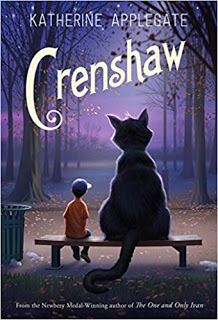
Looking back, what do I wish I had learned then--instead of twenty years later?
Pay attention.
Find the positive.
Learn how to absorb criticism.
Trust your instincts.
Be patient.
But above all else, keep writing.
I wrote BERT TO THE RESCUE at a time when I was also writing plays, short stories, adult novels, essays -- basically anything I could think of in hopes of success. I had no idea what I was doing. No plan. No mentor. Just a naive belief that somehow or other success was around the corner.
"Bert" was based on a family legend. My great great aunt Elizabeth Moffett, who wrote for the Milwaukee Journal, used to talk for an imaginary cat named Bert. I combined Bert with my own miserable year at 4th grade. I knew someone who knew someone who knew someone at Knopf. And somehow got my manuscript read by an editor.

I remember being thrilled by this response -- even though, despite the praise, the envelope also contained my manuscript.

I incorporated the advice as best I could and resubmitted "Bert." A few months later, "Bert" came back, rejected once again, with more feedback from more editors.


So, dear readers, I'm sure you think that I immediately wrote another middle-grade novel, which was much much better because of the advice given to me by those three editors, and sent it to the first editor who had asked to see more of my work.
Nope. Instead I wrote more mediocre adult novels and esoteric plays, and half of a cancer memoir. None of which ever received half the praise that "Bert" had.
TWENTY YEARS later, I finally started another middle-grade novel.
My husband used to encourage me to take another stab at fixing "Bert." But I always told him that no one had any interest in a novel about an imaginary cat.

Looking back, what do I wish I had learned then--instead of twenty years later?
Pay attention.
Find the positive.
Learn how to absorb criticism.
Trust your instincts.
Be patient.
But above all else, keep writing.
Published on June 08, 2019 06:42
June 3, 2019
What I Learned from My First Completed Middle Grade Manuscript
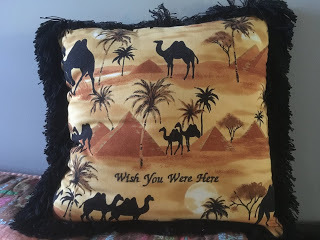 gift-pillow my mother made
gift-pillow my mother madeto commemorate my
first "book"
The first middle grade novel manuscript I completed was called WISH YOU WERE HERE, and it was about a girl's adventures as she searched for her birth-father.
When I attended my first SCBWI conference I signed up for a manuscript critique with an editor. My ms landed with Summer Laurie, then editor at now-defunct Tricycle Press.
I'll never forget how it felt when I met with Summer, and she told me she loved main character Cricket, and she thought I was onto something here, and would I send her the full manuscript? She was saying the words I'd always hoped to hear... my dream was coming true!
So, I sent her the manuscript. I waited, I hoped, I dreamed some more. When I heard from Summer a few months later, it was not the news I was hoping for. The manuscript wasn't ready, wasn't a good fit, wasn't – whatever. But would I please keep her in mind for future projects?
What did I learn from this experience? Well, about a billion things! Here are a few that leap to mind: SCBWI is awesome. I don't know where I'd be without this organization. Everything I know about publishing, and getting a book ready for publication, I learned at an SCBWI conference. (Shout-out to my Southern Breeze region!) Getting a request for a full ms does not guarantee a sell. There are a thousand reasons a manuscript gets rejected. Ultimately I'm glad that manuscript didn't sell. It wasn't the best first book for me. But I'd never have gotten to THAT book had I not written this one first. Children's book people are THE BEST. I'm still in touch with Laurie. She has continued to champion my books (and occasionally give feedback) through the years since we first met at that conference. The most important thing I learned from this first completed manuscript was... YES, I can finish a book. YES, someone out there will want to read it. YES, writing can be its own reward. And I will be “learning” to write for the rest of my life. I'm so grateful!
-------------Irene Latham lives on a lake in rural Alabama. Winner of the 2016 ILA Lee Bennett Hopkins Promising Poet Award, she is the author of hundreds of poems and nearly twenty current and forthcoming poetry, fiction and picture books from publishers including Penguin Random House, Macmillan, Lerner, Boyds Mills, and Charlesbridge. Her books have been recognized on state lists and honored by NEA, ALA, NCTE, SIBA, Bank Street College and other organizations.
Published on June 03, 2019 03:30
June 2, 2019
SMACK DAB NEWS
Claudia Mills launches a new series for younger-middle-grade readers - After-School Superstars - set in an after-school program, with a different themed "camp" each month. The first title, Nixie Ness, Cooking Star, with illustrations by Grace Zong, comes out on June 11 from Holiday House.
 Next up in the series will be Vera Vance, Comics Star, set in a comics-book camp.
Next up in the series will be Vera Vance, Comics Star, set in a comics-book camp.
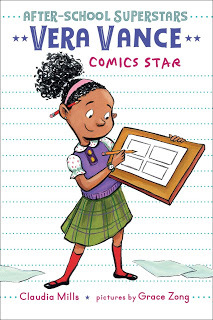 Then Nixie and Vera will be joined by followed by Lucy Lopez, Coding Star, set in a coding camp. The theme for the fourth camp is still to be determined. Suggestions welcome!
Then Nixie and Vera will be joined by followed by Lucy Lopez, Coding Star, set in a coding camp. The theme for the fourth camp is still to be determined. Suggestions welcome!
 Next up in the series will be Vera Vance, Comics Star, set in a comics-book camp.
Next up in the series will be Vera Vance, Comics Star, set in a comics-book camp. Then Nixie and Vera will be joined by followed by Lucy Lopez, Coding Star, set in a coding camp. The theme for the fourth camp is still to be determined. Suggestions welcome!
Then Nixie and Vera will be joined by followed by Lucy Lopez, Coding Star, set in a coding camp. The theme for the fourth camp is still to be determined. Suggestions welcome!
Published on June 02, 2019 14:12
May 30, 2019
Judging a Book by Its Cover

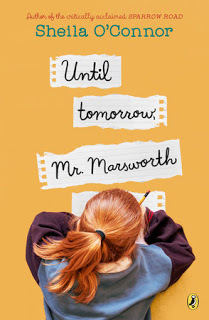
I have to admit, even six books into my publishing career, the initial “cover reveal” continues to thrill me. I’m not talking about the social media practice of revealing our covers to the public, but the private moment when the cover first appears in my email with the thrilling and slightly terrifying discovery of a stranger’s visual interpretation of my book. Encountering the cover for the first time, I see in living color what the designer has imagined from my words. If I’ve done my work well, the cover fits. The mood is right, the tone exactly what I’d hoped for as I wrote. In a perfect world, the thematic threads that mean the most to me are somehow surprisingly captured by another’s imagination.
And yet, what does it mean to love two covers for the same book—the hardcover and the paperback—to admire the interpretations of two very different designers? Does one cover have to be better? Does one cover have to be wrong? Is it possible for two wildly different covers to capture the heart of the same book? I had some time to think this through in April, when the paperback of UNTIL TOMORROW, MR. MARSWORTH launched with an entirely new cover. Sharing the new cover on social media, I immediately heard from readers who preferred one over the other. There were those who loved the first cover: the color, the peace sign at the center, the way it held the protagonists and hinted at the tale. And there were others who clearly preferred the second: the simplicity, the absence of character clues, the mystery of the red-haired girl, and unidentified subject. A novel with letters yes, that much was clear from that new cover, but who was Mr. Marsworth, and what was the book about? Some readers saw the paperback cover as an invitation, raising questions the other cover may have answered. For my part, I confess I love them both. I am happy Reenie and Mr. Marsworth starred on that first cover, happy the first cover clearly spoke of peace, but I am equally happy to have that mysterious girl penning a letter.
In the case of both SPARROW ROAD and UNTIL TOMORROW, MR. MARSWORTH, I’ve loved the experience of having two covers, and I’ve also enjoyed sharing the dual covers during school visits with interested readers. When I’m sharing both covers with a school, I like to ask the students what they think the images achieve. If we do indeed judge a book by a cover, what judgment do we reach with each rendition? Which one would they be most likely to read? Which one would catch their eye in a library or bookstore. Like the artists who designed them, every reader has their own opinion, their own aesthetic inclinations that draw them toward a book. It’s very possible the reader who picked up the book based on one cover, wouldn’t be attracted to the other, wouldn’t read the book, even though both covers held the identical story.
As an unexpected gift, this cover conversation presents an invaluable and immediate classroom lesson on the adage: “Looks can be deceiving.” Or, “you can’t judge a book by its cover.” And yet we do. It’s a lesson on packaging and sales, on how an artist’s vision shapes our expectations for a book. But perhaps most importantly it’s a lesson on how frequently we judge the inside by the outside, rightly or wrongly; a lesson that often has as much to do with living as it does with choosing books.
Published on May 30, 2019 05:00
May 29, 2019
.And The Title Is...
by Charlotte Bennardo
I have no freaking clue.
 photo courtesy of Pexels, Inc, Energepic
photo courtesy of Pexels, Inc, Energepic
I'm working on a new book and a title is eluding me. Whether it's for young adult, middle grade, chapter book, or even picture books, a title is a necessary thing. Sometimes we authors (with the okay from the editor) can take the easy way out and use one word, like Owls. If it's non-fiction, how easy is that? Trucks! Photography. And just as easy are several-word titles like: The Titanic. Amelia Earhart. The Civil War. Composing non-fiction titles I can do in my sleep.
Now fiction... sigh. Sometimes the titles come to me easily, like in my young adult novel, Ripples on Water. It's a line in the book, where a mischievous faerie is told by the King that the effects of her actions will be like... wait for it: ripples on water. It jumped out at me. That'a how it usually happens; I'm reading the manuscript and I know what the title will be, almost like the line or word is in bold, it's so obvious.
For my middle grade series, Evolution Revolution is the series name because that's what the book is about, a sudden intellectual evolution of a squirrel who learns how to use machines. So book one is Evolution Revolution: Simple Machines. The second book is Evolution Revolution: Simple Plans and the third is Evolution Revolution: Simple Lessons. All the titles reflect the main idea behind that book. Easy, peasey.
But now I'm struggling to find a title for my new YA sci fi, an homage to Mary Shelley's Frankenstein (which had a sub-title: Or, The Modern Prometheus). I cannot for the life of me construct a title. And even if I figure out what I think is the perfect one, an editor may change it. (Keep in mind they can make you change your title and you may not like it. Just like artwork, you don't always have a say.) Sirenz was originally Sirens but the editor thought that the 'z' would be more modern and appealing, even though we never spelled it that way in the books.)
Whether it's from a line in the manuscript, or a description of some aspect of the story, titles need to be attention grabbers. My colleagues have listed numerous successful titles in their posts. So here are some of the worst, courtesy of Book Riot. (Some are risque, so I'm not including a link, you'll have to look it up on your own.)
1- Reusing Old Graves.
2- Old Tractors and the Men Who Love Them
3- Fancy Coffins to Make Yourself
4- Corpses Say the Darndest Things
5- Nostradamus Ate My Hamster
6- What's Your Poo Telling You?
7- Divorcing A Real Witch
8- If God Loves Me, Why Can't I Get My Locker Open?
You have to wonder what the author and/or the editor was thinking (although to be fair, maybe the titles fit the books perfectly and that's the awful part.) Somehow I don't think any title I come up with can be this bad.
For fun, I made up several really, terribly, awful titles:
1. Everyone Really Hates High School, So There's No Happy Ending
2. Teen Drama, Get Over It
3. My Cat Beat Up Your Cat
4. Homework
5. Ask Your Mother What She Thinks
6. Chores I Love To Do
7. Playground Death Arena
8. How To Stuff Your Enemy Into A Locker
After the above, maybe the title I create for my manuscript won't be so bad... but then again...
I have no freaking clue.
 photo courtesy of Pexels, Inc, Energepic
photo courtesy of Pexels, Inc, EnergepicI'm working on a new book and a title is eluding me. Whether it's for young adult, middle grade, chapter book, or even picture books, a title is a necessary thing. Sometimes we authors (with the okay from the editor) can take the easy way out and use one word, like Owls. If it's non-fiction, how easy is that? Trucks! Photography. And just as easy are several-word titles like: The Titanic. Amelia Earhart. The Civil War. Composing non-fiction titles I can do in my sleep.
Now fiction... sigh. Sometimes the titles come to me easily, like in my young adult novel, Ripples on Water. It's a line in the book, where a mischievous faerie is told by the King that the effects of her actions will be like... wait for it: ripples on water. It jumped out at me. That'a how it usually happens; I'm reading the manuscript and I know what the title will be, almost like the line or word is in bold, it's so obvious.
For my middle grade series, Evolution Revolution is the series name because that's what the book is about, a sudden intellectual evolution of a squirrel who learns how to use machines. So book one is Evolution Revolution: Simple Machines. The second book is Evolution Revolution: Simple Plans and the third is Evolution Revolution: Simple Lessons. All the titles reflect the main idea behind that book. Easy, peasey.
But now I'm struggling to find a title for my new YA sci fi, an homage to Mary Shelley's Frankenstein (which had a sub-title: Or, The Modern Prometheus). I cannot for the life of me construct a title. And even if I figure out what I think is the perfect one, an editor may change it. (Keep in mind they can make you change your title and you may not like it. Just like artwork, you don't always have a say.) Sirenz was originally Sirens but the editor thought that the 'z' would be more modern and appealing, even though we never spelled it that way in the books.)
Whether it's from a line in the manuscript, or a description of some aspect of the story, titles need to be attention grabbers. My colleagues have listed numerous successful titles in their posts. So here are some of the worst, courtesy of Book Riot. (Some are risque, so I'm not including a link, you'll have to look it up on your own.)
1- Reusing Old Graves.
2- Old Tractors and the Men Who Love Them
3- Fancy Coffins to Make Yourself
4- Corpses Say the Darndest Things
5- Nostradamus Ate My Hamster
6- What's Your Poo Telling You?
7- Divorcing A Real Witch
8- If God Loves Me, Why Can't I Get My Locker Open?
You have to wonder what the author and/or the editor was thinking (although to be fair, maybe the titles fit the books perfectly and that's the awful part.) Somehow I don't think any title I come up with can be this bad.
For fun, I made up several really, terribly, awful titles:
1. Everyone Really Hates High School, So There's No Happy Ending
2. Teen Drama, Get Over It
3. My Cat Beat Up Your Cat
4. Homework
5. Ask Your Mother What She Thinks
6. Chores I Love To Do
7. Playground Death Arena
8. How To Stuff Your Enemy Into A Locker
After the above, maybe the title I create for my manuscript won't be so bad... but then again...
Published on May 29, 2019 07:30
May 27, 2019
And Now for Something Completely Different...
It's "Get Caught Reading" Month, and I never would've guessed what you'll catch me reading this May!
I was never one for math and science (my physics and chemistry teachers from high school probably still have PTSD!), but this month, I'm working on a STEM project, so I'm reading all sorts of things I never thought I'd look at twice.


So far, I'm loving Jack Challoner's Smithsonian STEM Lab, which explains lots of things I never bothered to even wonder about (if you need me to build you a raft out of empty water bottles, just let me know) and Catherine Thimmesh and Melissa Sweet's Girls Think of Everything , which had me at chapter one...when they paid homage to Ruth Wakefield, inventor of the chocolate chip cookie. I can't decide whether I should thank her profusely or curse the day I first savored one of her incredible inventions, but it was neat to learn her story!
I find that reading things outside my usual comfort zone is pretty cool. What about you? What will you get caught reading this month?
Ginger Rue is the author of the Aleca Zamm series from Aladdin and the Tig Ripley series from Sleeping Bear.
I was never one for math and science (my physics and chemistry teachers from high school probably still have PTSD!), but this month, I'm working on a STEM project, so I'm reading all sorts of things I never thought I'd look at twice.


So far, I'm loving Jack Challoner's Smithsonian STEM Lab, which explains lots of things I never bothered to even wonder about (if you need me to build you a raft out of empty water bottles, just let me know) and Catherine Thimmesh and Melissa Sweet's Girls Think of Everything , which had me at chapter one...when they paid homage to Ruth Wakefield, inventor of the chocolate chip cookie. I can't decide whether I should thank her profusely or curse the day I first savored one of her incredible inventions, but it was neat to learn her story!
I find that reading things outside my usual comfort zone is pretty cool. What about you? What will you get caught reading this month?
Ginger Rue is the author of the Aleca Zamm series from Aladdin and the Tig Ripley series from Sleeping Bear.
Published on May 27, 2019 22:00
May 23, 2019
BOOK RECOMMENDATION: SHRED GIRLS (Holly Schindler)
I have to admit--I just completely fell in love with this one:
 Moll Hurford's SHRED GIRLS has a pitch-perfect MG voice and features a young comic book junkie who learns, over the course of the summer, that perhaps the real-life adventures on a bike just might be even cooler than the adventures found on the panels and pages of her much-loved comics.
Moll Hurford's SHRED GIRLS has a pitch-perfect MG voice and features a young comic book junkie who learns, over the course of the summer, that perhaps the real-life adventures on a bike just might be even cooler than the adventures found on the panels and pages of her much-loved comics.
Violet Lemay's illustrations are also fantastic:
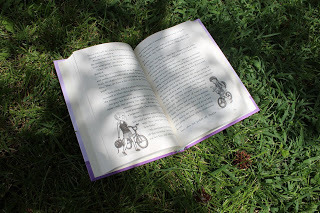
And I love the asides--the "Training Log" and "Superhero Tips" that often wrap up chapters: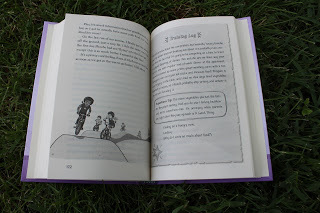
A great under-the-tree read this summer. Would be a perfect match for young readers who often gravitate toward illustrated works. Also a solid choice for classroom libraries. I'm betting teachers will have to create a waiting list for this one!
 Moll Hurford's SHRED GIRLS has a pitch-perfect MG voice and features a young comic book junkie who learns, over the course of the summer, that perhaps the real-life adventures on a bike just might be even cooler than the adventures found on the panels and pages of her much-loved comics.
Moll Hurford's SHRED GIRLS has a pitch-perfect MG voice and features a young comic book junkie who learns, over the course of the summer, that perhaps the real-life adventures on a bike just might be even cooler than the adventures found on the panels and pages of her much-loved comics.Violet Lemay's illustrations are also fantastic:

And I love the asides--the "Training Log" and "Superhero Tips" that often wrap up chapters:

A great under-the-tree read this summer. Would be a perfect match for young readers who often gravitate toward illustrated works. Also a solid choice for classroom libraries. I'm betting teachers will have to create a waiting list for this one!
Published on May 23, 2019 23:30
May 22, 2019
Imagination Station: Smack Dab in the Imagination by Dia Calhoun
I love the phrase Imagination Station--the playfulness, the rhyme, the meaning. Whoever thought of that was abounding in imagination.
We should all create our own Imagination Stations. As a writer I especially like the parallel with a train station. I can pull into my Imagination Station when ever I'm stuck on a project to figure out a next chapter, plot element, or even a new story.
I think I'll start with a medium size station, with say, seven platforms. All connect to a train heading to different destinations. I'll hop on one and see where it goes. Then I'll return to the station and hop on a different train until I find my way.
Einstein hopped an imaginary train to "ride on a beam of light" as he delved into his theory of relativity. Consider how many platforms he must have had in that genius mind!
Create an Imagination Station for kids at home, in a classroom. Have it filled with colored pencils, paper, scissors, clay, books, old magazines for collage.
An Imagination Station is a point of departure. Where will you go?
We should all create our own Imagination Stations. As a writer I especially like the parallel with a train station. I can pull into my Imagination Station when ever I'm stuck on a project to figure out a next chapter, plot element, or even a new story.
I think I'll start with a medium size station, with say, seven platforms. All connect to a train heading to different destinations. I'll hop on one and see where it goes. Then I'll return to the station and hop on a different train until I find my way.
Einstein hopped an imaginary train to "ride on a beam of light" as he delved into his theory of relativity. Consider how many platforms he must have had in that genius mind!
Create an Imagination Station for kids at home, in a classroom. Have it filled with colored pencils, paper, scissors, clay, books, old magazines for collage.
An Imagination Station is a point of departure. Where will you go?
Published on May 22, 2019 22:58



